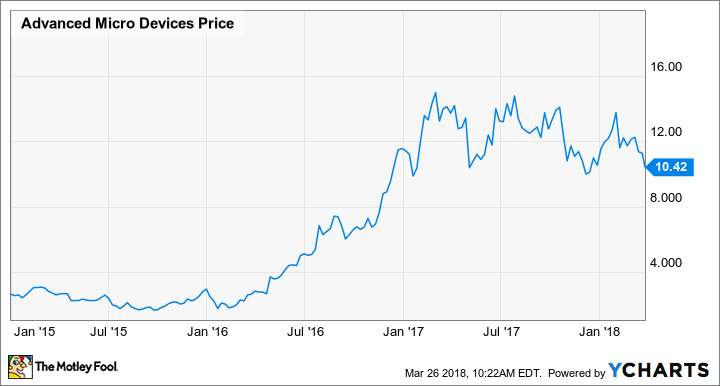Shares of Advanced Micro Devices (AMD -4.26%) have gone nowhere since the beginning of 2017. The stock has been oscillating following a spectacular rally in 2016, which was driven by intense optimism surrounding the company's turnaround.
Indeed, AMD's revenue has soared since bottoming out in 2015, and the company turned a profit last year for the first time since 2011. But a significant portion of its success has been driven by demand originating from cryptocurrency miners, who use graphics cards to number-crunch their way to profits. And at least one analyst sees trouble ahead for that particular part of AMD's business.
Specialized hardware is coming
Graphics cards are great at doing the types of calculations involved in mining cryptocurrency. But an application-specific integrated circuit, or ASIC, designed at the hardware level for mining a particular cryptocurrency can blow a more general-purpose GPU out of the water. ASICs for mining bitcoin have been around for years, and large-scale bitcoin mining operations use them by the thousands.
But there are other cryptocurrencies -- over 1,600 -- that aren't yet mainstream enough to warrant the development of ASICs. For these cryptocurrencies, using off-the-shelf graphics cards for mining is still the best option. Ethereum, the second largest cryptocurrency by market capitalization, has played a big role in driving demand for graphics cards over the past year.
Ethereum is now reportedly getting its own ASIC, courtesy of Bitmain Technologies. In a report on Monday, an analyst at Susquehanna Financial Group said that Bitmain is starting production of an Ethereum ASIC this quarter, with production ramping up in May. That was enough for the analyst to downgrade AMD stock to negative from neutral. The analyst's also dropped the price target on the stock all the way to $7.50, from a previous target of $13.
An ASIC for Ethereum would render GPUs largely obsolete for the purposes of mining. There are plenty of other cryptocurrencies, but many of them have lost quite a bit of value this year amid the ongoing cryptocurrency reckoning. The analyst believes that around 20% of AMD's revenue could be impacted by the loss of sales to Ethereum miners.

Image source: AMD.
This was bound to happen
That 20% of revenue estimate may be on the high side. GPU sales to cryptocurrency miners totaled $776 million last year, according to calculations by Jon Peddie Research, with AMD being the primary benefactor. If AMD soaked up two-thirds of that revenue, cryptocurrency demand would account for about 10% of its total revenue, and about half of its revenue growth in 2017.
Still, that's a lot of revenue that could potentially disappear. The problem with banking on cryptocurrency miners for GPU sales is that there are only two paths forward, and both lead to those sales vanishing. Either the cryptocurrency in question collapses in price, rendering mining unprofitable, or it becomes popular and valuable enough to trigger ASIC development. Either way, the gold mine eventually runs dry for AMD.
AMD has other products that can drive growth. It plans to launch a refresh of its Ryzen PC CPUs this year, and it's continuing to ramp up its EPYC server chips as it aims to steal away market share from Intel. But if the bottom truly falls out of the cryptocurrency market, due to either a crash in prices or specialized hardware supplanting the company's GPUs, it will be mighty difficult to replace that lost revenue.






